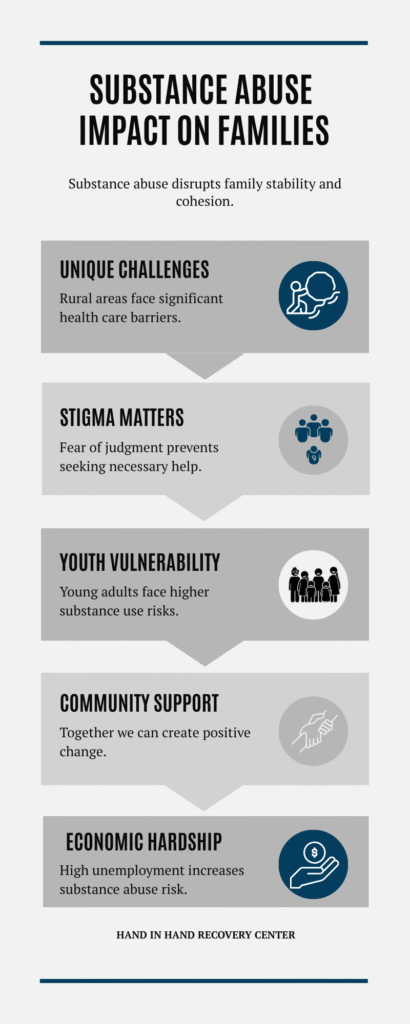Substance abuse is a multifaceted public health challenge that reverberates throughout rural areas and small towns across the nation. In these communities, the convergence of economic hardship, limited healthcare access, and deeply rooted social stigma has created an environment in which substance use disorders flourish.
Although much public discourse has focused on urban drug crises, rural America faces its unique struggles. This crisis is not only marked by higher rates of illicit drug use—including opioids, methamphetamine, and alcohol—but also by disproportionately high drug overdose deaths and severe barriers to treatment services.
For many individuals, especially men and young adults in metro Atlanta and its neighboring communities, the effects of substance abuse are compounded by isolation, financial stress, and a persistent shortage of mental health providers.
Hand in Hand Recovery Center recognizes the complex realities of substance abuse in rural areas. This article addresses current trends, structural challenges, population impacts, and promising interventions.

Overview of Substance Abuse in Rural Areas
Substance abuse in rural communities is a growing crisis, driven by a combination of high-risk behaviors, limited treatment options, and ongoing socioeconomic challenges.
Recent statistics from leading sources such as the Centers for Disease Control and Prevention (CDC), Substance Abuse and Mental Health Services Administration (SAMHSA), and the National Institute on Drug Abuse (NIDA) reveal that rural residents experience higher rates of substance use disorder compared to their urban counterparts.
Contemporary Trends in Substance Use
Data collected in 2023 and 2024 highlight significant trends across several substances:
- In rural communities, alcohol consumption and binge drinking remain prevalent, with studies showing that rural adolescents and young adults often exhibit higher levels of heavy drinking compared to those in urban areas.
- A similar trend in the misuse of opioids and methamphetamine frequently accompanies these patterns. For example, while opioid misuse—including the nonmedical use of prescription drugs and illicit opioid use—has permeated both rural and urban settings, rural counties report marginally higher percentages of opioid misuse.
- Rising opioid overdose deaths, particularly those associated with synthetic opioids like fentanyl, have become a hallmark of the crisis, underscoring disparities in emergency care and harm reduction initiatives.
- Methamphetamine use also demonstrates a distinctive rural profile, with prevalence rates that outpace those in urban counties.
- Alongside these trends, the widespread availability of prescription drugs, especially pain relievers, contributes to a complex pattern of polysubstance use that dramatically increases the risk of overdose death.
- Alcohol, often viewed as socially acceptable, compounds the issue; its frequent misuse adds a layer of public health concern that impacts both behavioral health and long-term health outcomes.
Rural vs. Urban Disparities
Comparative studies indicate that although urban areas might experience significant substance use concerns, rural areas face unique challenges in addressing the crisis. Limited health care infrastructure, fewer treatment centers, and longer travel distances to receive care are exacerbated by the lingering stigma associated with substance abuse in small towns.
In many rural communities, treating substance use disorders requires interventions that go beyond medication-assisted treatment (MAT) and counseling—it demands comprehensive policy solutions, community support programs, and innovative approaches like telehealth services.
Unique Challenges Faced by Rural Communities
Substance abuse in rural America is fueled by a set of challenges that are not as prominent in urban centers. These challenges extend beyond medical issues to include deep-seated social and economic obstacles.
Provider Shortages and Limited Health Care Access
One of the most pressing problems confronting rural residents is the pervasive shortage of healthcare providers. In many rural counties, a lack of specialized professionals in mental health and addiction treatment creates a significant barrier to care.
Local treatment centers are few and far between, meaning individuals often must travel long distances to access critical services.
This geographic isolation, coupled with insufficient numbers of providers, compromises early intervention efforts and prevents many sufferers from receiving timely care.
The challenges of recruiting and retaining qualified clinicians in rural communities are acute. Often, the few available treatment centers struggle with low funding, limiting their capacity to serve the local population effectively.
Economic realities exacerbate these problems—rural areas frequently have lower levels of health insurance coverage and higher rates of poverty, both of which limit the ability to pay for consistent treatment, including outpatient and inpatient programs.

Social Stigma and Community Dynamics
The stigma attached to substance abuse in rural areas remains a formidable barrier. In tight-knit small towns where personal relationships are paramount, the fear of judgment and ostracism can prevent individuals from seeking help.
Many rural residents view substance use disorder as a moral failing rather than a chronic, treatable condition. This perspective isolates individuals and discourages discussion and early intervention in treatment services.
In many cases, community members may hesitate to use available behavioral health programs due to privacy concerns. The intimate nature of rural social networks means that personal health challenges, including addiction, can become public knowledge rapidly, deterring individuals from accessing treatment even if it is available.
Economic Hardship and Poverty
Economic conditions in rural areas further exacerbate issues related to substance abuse. High unemployment rates and chronic underemployment lead to significant financial stress, which is among the root causes of substance use disorder.
When individuals face limited job opportunities and economic instability, feelings of hopelessness and despair can drive the misuse of drugs and alcohol as a form of escape.
The financial burden extends beyond the personal level; families in rural communities often suffer from the ripple effects of economic hardship. Substance abuse, in turn, places additional strain on local economies by reducing workforce productivity and increasing social service costs.
In many cases, the economic downturn not only fuels addiction but also undercuts the ability of local governments to implement robust prevention and intervention programs.
Impact on Rural Populations and Families
The consequences of substance abuse in rural areas extend far beyond individual struggles, affecting entire families and communities. The social, economic, and public health ripple effects are significant.
Families and Community Well-Being
Within rural communities, families are typically the first to feel the impact of substance use disorder. Children, adolescents, and elderly family members often bear the brunt of the instability caused by a loved one’s addiction—ranging from financial instability and emotional trauma to disruptions in education and social development.
The effects can be intergenerational, with children in these households often facing higher risks of becoming involved in substance use themselves.
Community well-being is compromised as well, leading to a decrease in overall social cohesion and increased behavioral health challenges.
In many small towns, the collective trauma of substance abuse can lead to a cycle of despair where community members feel powerless to effect change, further entrenching high rates of drug abuse, relapse, and overdose deaths.

Impact on Adolescents and Young Adults
Data from the Rural Health Information Hub highlight that adolescents and young adults in rural areas are especially susceptible to high-risk behaviors, including heavy alcohol use and illicit drug consumption.
These individuals are frequently exposed to an environment where substance use is intertwined with the local identity, especially in the absence of strong preventative programs. The high prevalence of binge drinking, opioid misuse, and methamphetamine use among rural youth not only affects their immediate health but also jeopardizes their long-term prospects via academic, social, and economic pathways.
For young adults, substance abuse can undermine future opportunities. Educational attainment may fall as a result of substance-related issues, while job prospects diminish in an already economically challenged environment.
Moreover, the combination of substance abuse with mental health disorders—which remains underdiagnosed in these communities—creates a dangerous cycle that affects decision-making and increases the risk of fatal outcomes such as an opioid overdose.
Disproportionate Impacts on Men
Men in rural areas exhibit a particularly troubling trend when it comes to substance abuse. Cultural norms that equate masculinity with stoicism and self-reliance often prevent men from seeking help.
This reluctance, combined with high-pressure work environments that frequently involve physically demanding occupations such as farming, mining, or manufacturing, escalates the risk of developing a substance use disorder.
The misuse of prescription opioids and illicit drugs among rural men is compounded by limited access to both prevention and treatment services—a situation aggravated by economic stress and reduced availability of mental health care.
Studies from initiatives like the CDC’s rural health reports consistently find that these factors lead to higher rates of overdose deaths among rural men compared to their urban counterparts.
The interplay of societal expectations, economic hardship, and inadequate support infrastructure creates an environment where substance abuse becomes a dangerous secret shared by too many.
Barriers to Treatment and Access to Care
Efforts to address substance abuse in rural communities face significant hurdles—chief among them a pervasive lack of access to effective treatment and support systems.
Access and Availability of Treatment Services
In rural America, the scarcity of treatment centers dedicated to substance abuse treatment is an ongoing crisis. Many rural counties lack inpatient and outpatient facilities capable of providing comprehensive care.
Even when services are available, they are often limited in scope, with long wait times and inflexible schedules that are ill-suited to the needs of individuals living in areas with scarce public transportation.
Medication-assisted treatment (MAT) programs, which have proven effective in treating opioid use disorder, are not as readily available in rural communities. The shortage of providers trained to administer MAT means that even individuals who have sought help must contend with delays in receiving care—delays that can prove fatal in the case of an overdose.
Furthermore, the limited availability of integrated care systems that combine mental health, primary care, and substance abuse treatment stalls the implementation of evidence-based approaches that have been successful in urban centers.
Financial and Insurance Barriers
The economic obstacles endemic to rural areas compound the problem of access. Many rural residents lack comprehensive health insurance or face significant out-of-pocket costs, including high copayments and deductibles, which create additional barriers to obtaining treatment.
These financial realities are particularly significant for low-income families and individuals, who may be forced to choose between essential expenses such as housing and treatment services.
Additionally, the cost of staying engaged in long-term recovery often outweighs the perceived benefits of immediate treatment for many rural residents. With fewer alternative resources available, such as telehealth services or community outreach programs, individuals are left with few options to address their substance use disorder promptly and effectively.
Transportation and Geographic Isolation
Transportation remains a critical barrier in rural communities. For many rural residents, the nearest treatment facility may be several hours away, making regular attendance at therapy sessions or MAT appointments challenging, if not impossible.
Geographic isolation, with limited public transportation options, forces many individuals to rely on inconsistent personal transportation networks.
Such logistical hurdles not only delay care but also contribute to a cycle of relapse and worsening health outcomes.

Initiatives, Interventions, and Evidence-Based Programs
In response to the growing crisis of substance abuse in rural areas, various evidence-based initiatives and interventions have been introduced at the local, state, and federal levels. These efforts are designed to mitigate the challenges posed by limited healthcare and economic constraints and offer promising paths forward for affected communities.
Federal and State Level Initiatives
Government agencies, including the CDC, SAMHSA, and the National Institute on Drug Abuse, have been actively involved in monitoring trends and funding programs that promote effective substance abuse treatment.
Recent initiatives focus on reducing overdose death rates through enhanced distribution of naloxone, the opioid overdose reversal agent, and by targeting rural populations through increased outreach.
State-level interventions have also emphasized expanding treatment options in rural areas. Programs that integrate primary care with mental health services have been successful in improving access to treatment, while telehealth initiatives offer a promising solution to overcome geographic isolation.
For example, increased funding for broadband infrastructure has enabled remote behavioral health consultations, vital for individuals living in rural counties where in-person providers are scarce.
Community-Based and Evidence-Based Approaches
At the community level, local organizations have implemented models of care that blend prevention, intervention, and recovery support. Many small towns have seen the emergence of mobile treatment centers, units that traverse rural America to provide screening, brief interventions, and referrals to treatment services.
These initiatives represent a vital step in bridging the treatment gap that has long characterized rural health.
Evidence-based prevention programs aimed at adolescents and young adults have also gained traction. By utilizing data from the Centers for Disease Control and Prevention and other health research bodies, community programs aim to educate residents about the risks associated with substance use and to promote healthier coping strategies.
Efforts to reduce stigma are another important dimension of these interventions. Public health campaigns that reframe substance use disorder as a treatable medical condition, rather than a moral failing, help to foster a more open dialogue about addiction.
These campaigns, alongside targeted outreach efforts involving law enforcement and local human services, encourage individuals to seek help without fear of judgment.
Innovative Treatment Models
Innovative treatment models, including dual-diagnosis programs that address substance use and underlying mental health challenges, have shown promise in rural settings. The integration of outpatient and inpatient services, along with the broader adoption of medication-assisted treatment (MAT), has the potential to reduce relapse rates and improve long-term recovery outcomes significantly.
Furthermore, partnerships between community health centers and larger urban hospitals have facilitated the transfer of best practices and provided rural residents access to expertise that was once only available in urban areas.
These evidence-based interventions, supported by federal funding and guided by the latest research, offer a clear path toward reducing the prevalence of substance abuse in rural communities.
By addressing both the immediate needs and the underlying causes of addiction, these programs help to create a more cohesive, empowered society that is better equipped to combat the crisis.

Connecting Rural Crisis to Metro Atlanta and Surrounding Regions
While the substance abuse crisis is deeply rooted in rural America, its influence extends into urban areas and regions such as metro Atlanta, which serve as hubs for migration and economic activity.
Many men in metro Atlanta have familial ties to rural communities, and the cultural and socioeconomic factors prevalent in small towns often mirror the challenges seen in larger urban centers.
As rural residents relocate or commute to metro areas seeking better economic opportunities, the risk factors associated with substance use disorder follow them, necessitating robust, locally available treatment options.
In metro Atlanta, the merging of rural and urban trends has created a unique environment where the substance abuse crisis is both visible and scalable.
The same issues of limited mental health services, provider shortages, and economic disparities that plague rural counties also contribute to rising episodes of overdose deaths and untreated substance use disorders in the metro area.
Recognizing this intersection, local health authorities have begun implementing integrated treatment models that provide tailored outreach and comprehensive care. These models ensure that all residents, whether in the city’s heart or on its outskirts, have access to the necessary resources to overcome addiction.
The convergence of rural and urban challenges in metro Atlanta underscores the need for a collaborative approach that harnesses community support, innovative treatment options, and coordinated public health interventions.
For individuals struggling with addiction in these areas, the path to recovery begins with understanding that help is available, regardless of geographic location.
We Provide a Hand Up
The evidence is clear: substance abuse in rural areas and small towns is a growing crisis that demands urgent, targeted action. The challenges faced by rural communities intensify the risks associated with opioid misuse, methamphetamine, and alcohol abuse.
This crisis is not confined to statistics; it impacts families, disrupts communities, and leaves a lasting imprint on the lives of men, young adults, and other vulnerable populations.
For those who find themselves caught in this cycle of substance abuse, recovery is within reach. The challenges are significant, but so too is the resilience of rural communities.
Individuals can navigate the pathway toward recovery by engaging with supportive treatment programs and accessing compassionate care.
At Hand in Hand Recovery Center, we are committed to standing alongside you on this journey. We understand the unique struggles of rural life and the intersection of economic and social challenges that contribute to addiction.
If you or a loved one is grappling with a substance use disorder, know that help is available. Take the brave step toward recovery today by reaching out for support. Whether you need immediate assistance or long-term treatment planning, our dedicated team is here to provide guidance, compassion, and expert care.
Together, we can turn the tide on this growing crisis and pave the way for healthier, more resilient communities. Embrace recovery, access treatment, and join a movement dedicated to saving lives and restoring hope in every corner of rural America. Call us at (470) 280-2791 to continue the conversation.

 info@handinhandrecovery.com
info@handinhandrecovery.com 3411 Austell Road Suite 200, Marietta, Georgia, United States
3411 Austell Road Suite 200, Marietta, Georgia, United States

